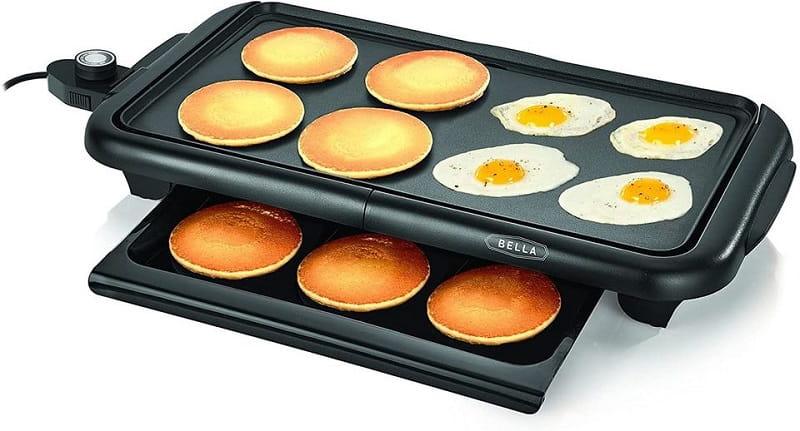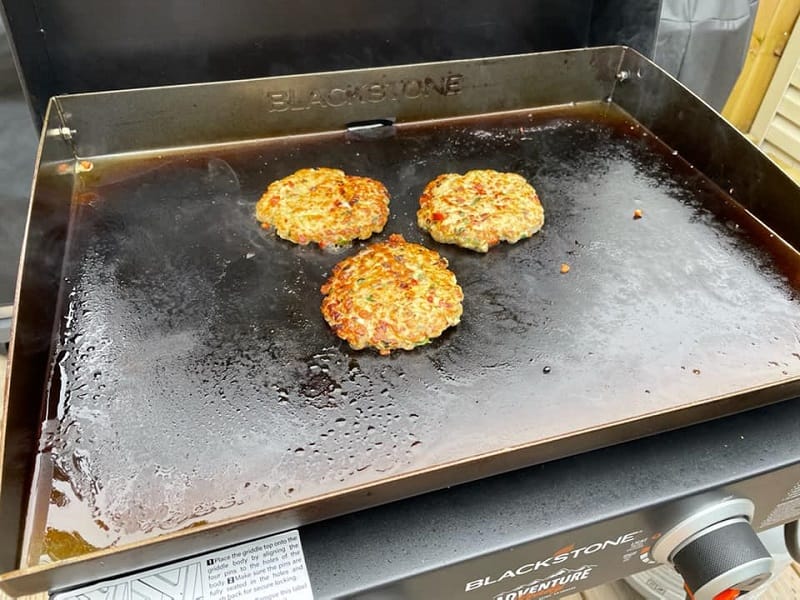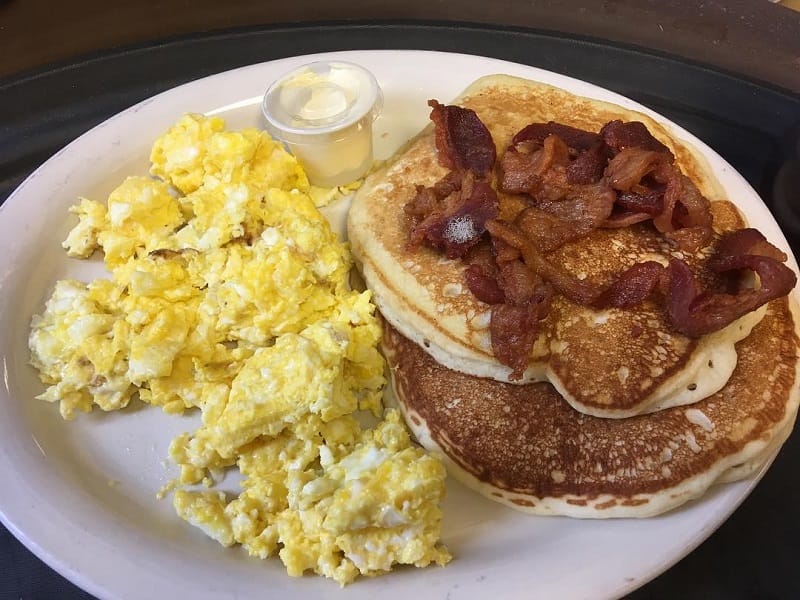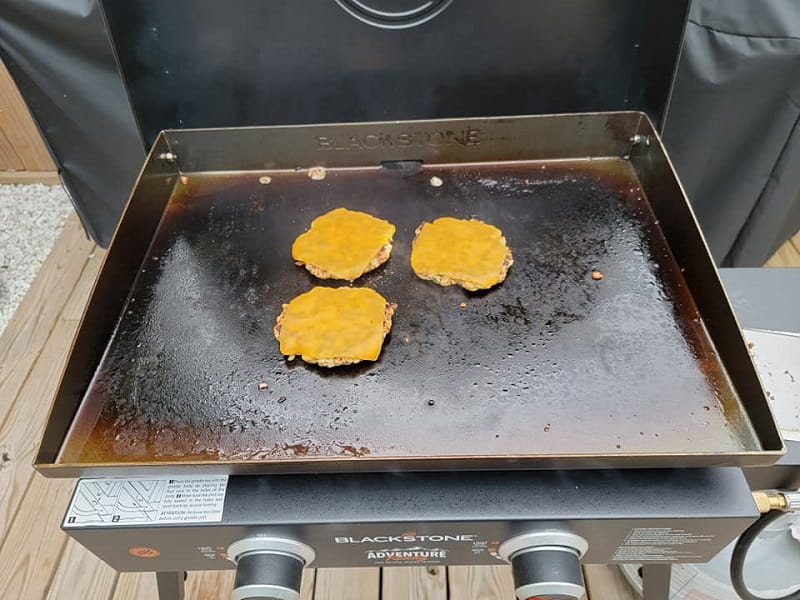Cooking eggs on a griddle can be a great way to make breakfast. But, if you’re not careful, you may end up with overcooked or undercooked eggs. That’s why knowing the right griddle temperature for your eggs is important. The ideal griddle temp for eggs will depend on the egg type and how you like them cooked.
In this article, we’ll discuss the best griddle temperature for different types of eggs and provide some tips on how to get perfect results every time. So whether you prefer sunny-side up, over easy, or anything in between, you can use this guide to find the best griddle temp for your eggs.
What Are The Benefits Of Using A Non-Stick Griddle For Cooking Eggs?

As someone with extensive experience and cooking expertise, I can confidently say that using a non-stick griddle for cooking eggs is a game-changer. Not only does it make cooking eggs easier, but it also comes with a range of benefits that can significantly improve your overall cooking experience.
Firstly, using a non-stick griddle means you don’t have to worry about your eggs sticking to the pan. This is especially important when making delicate dishes like omelets or sunny-side-up eggs. There’s nothing more frustrating than spending time and effort carefully preparing your eggs, only to have them ruined because they stick to the pan. With a non-stick griddle, you can avoid this problem altogether.
Another benefit of using a non-stick griddle for cooking eggs is that it requires less oil or butter. This is because the non-stick surface prevents the eggs from sticking, so you don’t need to use as much oil or butter to prevent them from sticking. This means your eggs will be healthier, with fewer calories and less fat.
In addition to being healthier, using a non-stick griddle can save you time and energy. This is because the even heat distribution of the griddle means that your eggs cook faster and more evenly. You don’t have to worry about hot or cold spots, which can cause your eggs to cook unevenly and take longer.
Using a non-stick griddle can also make cleaning up a breeze. Because the eggs don’t stick to the surface, you can wipe the griddle clean with a damp cloth or sponge. There’s no need to spend time scrubbing away at stuck-on egg residue, which can be a real pain if you’re in a hurry or don’t want to spend too much time cleaning up.
Overall, using a non-stick griddle for cooking eggs is a smart choice for anyone who wants to make their cooking experience easier, healthier, and more efficient. Whether you’re a seasoned cook or just starting, investing in a quality non-stick griddle can make a big difference in the quality and consistency of your egg dishes. So why not try it and see just how beneficial it can be?
What is Griddle Temp for Eggs?
The ideal griddle temperature for scrambled eggs is between 275 and 325 degrees Fahrenheit. However, it isn’t easy to give an exact cooking temperature due to the fluctuation in temperature on the griddle and the difference in temperature between different surface areas.
Preheating the griddle before cooking is crucial. Oil with a high smoke point, such as vegetable or avocado, should prevent eggs from sticking. Adding water, milk, or cream to scrambled eggs does not significantly affect their flavor, with butter being the best addition for taste.
Different cooking methods on an electric griddle, such as scrambled eggs, eggs over easy, sunny-side up, and omelets, require varying temperatures and cooking times. Unfresh eggs will negatively impact the taste and quality of cooked eggs.
Scrambled Eggs
When it comes to making scrambled eggs on a griddle, the temperature is crucial. The recommended griddle temperature for scrambled eggs ranges between 275-325 degrees Fahrenheit. However, due to the fluctuating temperature of the griddle and its surface area, it can be challenging to maintain a consistent temperature throughout the cooking process.
Overcooking or undercooking eggs on the griddle can make them too brown, cold, or dry. Therefore, getting the griddle temperature right is essential to ensure your scrambled eggs come out light, fluffy, and delicious every time.
Sunny-Side Up
When cooking sunny-side-up eggs on a griddle, the temperature is a crucial factor that should not be overlooked. For optimum results, it is recommended to preheat the griddle to a low heat of around 300 degrees Fahrenheit. This will allow for even heat distribution and ensure the egg does not burn or overcook.
For electric griddles, it is recommended to preheat to about 325 degrees Fahrenheit and use an oil with a high smoke point to prevent sticking.
Omelet
The ideal temperature for making a griddle omelet is around 375°F. A too-hot griddle can burn the bottom of the omelet, resulting in an unappetizing taste and texture. Conversely, a too-cool griddle will not cook the omelet evenly and may result in a runny center.
It is important to take time to properly preheat the griddle to ensure it reaches the optimal temperature before adding the omelet mixture. It is also recommended to use a thermometer to measure the temperature accurately. However, this may not be necessary for experienced cooks who can rely on visual cues such as butter or oil sizzling sound.
Eggs Over Easy
The ideal griddle temperature for cooking eggs over easy is 275 to 325 degrees Fahrenheit or approximately medium heat. This temperature range allows for even cooking without burning or overcooking the eggs. It is crucial to heat the griddle thoroughly before cooking eggs to ensure they do not stick to the surface.
A non-stick griddle or a light layer of oil or butter is recommended to prevent sticking and add flavor to the eggs. To achieve perfectly cooked eggs over easy, allow the egg to cook on one side for approximately five minutes and then gently flip it over for an additional one to two minutes of cooking on the second side. Always use a spatula to flip the eggs to prevent breaking the yolk.
Eggs Over Hard
The middle temperature for eggs over hard is typically between 325-350°F. It is important to note that the temperature may vary depending on the type of griddle used and the specific preferences of the cook.
When cooking eggs over hard, using a non-stick griddle and adding a small amount of oil or butter is recommended to prevent sticking. Preheating the griddle before adding the eggs is important to ensure even cooking.
Generally, eggs over hard are cooked on each side for 2-3 minutes until the yolk is completely cooked and the egg is firm. The key to achieving perfect eggs over hard is working with a low to medium heat level and taking into consideration the cooking time and temperature.
Eggs Over Medium
The griddle temperature for cooking eggs over medium can range from 275°F to 325°F, depending on the type of griddle and eggs. It is recommended to use a low to medium heat level and not go above 325°F to avoid burnt or overcooked eggs. Sunny-side-up and over-easy eggs should be cooked until the whites are fully cooked and the yolk is still soft. The whites should be opaque and the yolk slightly set but still runny for over-medium eggs.
Preheating the griddle and using oil with a high smoke point are crucial to prevent sticking. Butter can also be used for a creamy flavor. Cooking times may vary, but generally, medium eggs require 5-6 minutes on the first side and 1-2 minutes on the other side. A meat thermometer can be used to gauge the griddle temperature accurately.
Fried Egg
To achieve the best result, it is recommended to heat the griddle to around 325 degrees Fahrenheit. Once the griddle is hot enough, add butter or vegetable oil to the surface before cracking the egg. The key is to cook the egg at a low temperature for about 4-6 minutes until the whites are set, which helps prevent the egg from burning.
For an over-easy fried egg, cook until the white part sets before flipping the egg slowly, allowing the yolk to remain runny. For over-medium, flip the egg when the white part is set and cook for two minutes on the other side. For over-hard, allow the egg to cook for at least three minutes once flipped.
Using the right oil, like olive oil, and properly cracking the egg are equally important factors in achieving the perfect fried egg on a griddle.
Mini Frittatas
The griddle temperature for mini frittatas typically depends on the cooking method.
- If using a muffin tin and baking in an oven, preheat to 375°F and bake for 8-10 minutes or until the egg mixture is puffed and set in the center.
- If cooking on a griddle or stovetop, preheat to medium heat and cook for 2-3 minutes per side or until the mini frittata is fully cooked.
A nonstick spray or a well-oiled surface is important to prevent sticking and ensure even cooking. Mini frittatas are a versatile and easy-to-make option for breakfast or brunch, customizable with various meats, vegetables, and cheeses.
Read more:
- How Hot Does A Blackstone Griddle Get
- Can You Deep Fry An Egg
- Griddle Vs Grill
- Egg Beaters Vs Egg Whites
- How To Clean An Electric Griddle
How Can I Tell If My Griddle Is Too Hot Or Too Cold For Cooking Eggs?

Griddle cooking is one of the most popular methods for cooking breakfast foods, especially eggs. But getting the right temperature on your griddle can be tricky. Here’s a guide to help you determine if your griddle is too hot or too cold for cooking eggs.
Before cooking eggs on a griddle, it needs to be preheated. Preheating the griddle on low to medium heat for about 5 minutes is recommended for best results.
Conduct a drop test to determine if your griddle is too hot or cold. This test involves putting a small drop of water on the griddle. The griddle is too hot if the water droplet sizzles and evaporates quickly. If the water droplet sits on the griddle without sizzling, then the griddle is too cold.
If the griddle is too hot, adjust the temperature by lowering the heat. If the griddle is too cold, adjust the temperature by increasing the heat. Wait a few minutes and then perform the drop test again.
As you cook the eggs, be sure to monitor the cooking process. If the eggs cook too quickly, the griddle is too hot and must be adjusted. If the eggs are cooking too slowly, the griddle is too cold and must be adjusted.
These steps will help you determine if your griddle is too hot or cold for cooking eggs. Remember, a well-preheated griddle and proper temperature are essential for cooking delicious eggs on a griddle.
Can The Temperature Of The Griddle Affect The Nutritional Value Of The Eggs?
The grill can affect the nutritional value of eggs to a certain extent. Different cooking methods can cause slight changes in the nutritional values of eggs. Heat causes the composition of eggs to change, and the longer and hotter they are cooked, the more nutrients may be lost.
For instance, scrambling eggs causes a decrease in B vitamins and selenium but keeps more healthy fats, vitamin D, and vitamin K compared to boiling. Frying eggs can cause the cholesterol in them to become oxidized and produce compounds known as oxysterols because of the high heat. On the other hand, boiling eggs can decrease amounts of lutein and zeaxanthin, which are good for eye health, and soft boiling instead of hard boiling can help retain more of these nutrients since they are found in egg yolks.
However, cooking an egg increases protein availability for the body to 91% compared to only 51% in a raw egg. Cooking also increases digestibility and removes the risk of salmonella poisoning. Despite slight alterations, eggs remain a good source of various nutrients.
Tools For Frying Eggs On A Griddle

When cooking eggs on a griddle, having the right tools can make all the difference, and every cook should have a few essential tools in their kitchen.
First and foremost, you need a good quality griddle. Whether you prefer a cast iron griddle or a non-stick griddle, it’s important to invest in one that is durable and easy to clean. A griddle with a smooth surface is ideal for frying eggs, as it allows for even heat distribution and prevents any sticking or burning.
Next, you’ll need a spatula. A good spatula should be sturdy enough to flip eggs without breaking the yolk and flexible enough to easily slide under the egg without tearing it. Look for a spatula with a thin edge and a comfortable grip, which will make flipping eggs a breeze.
Another tool that can be helpful when frying eggs on a griddle is a basting cover. A basting cover is a metal or glass lid that fits over your griddle. This cover traps heat and steam, allowing the eggs to cook evenly and quickly. Plus, it prevents any splattering or mess on your stovetop.
Finally, consider investing in an egg ring. An egg ring is a small metal or silicone ring that sits on your griddle and holds the egg perfectly round. This can be especially helpful if you’re cooking eggs for a crowd or want to impress your guests with perfectly shaped eggs.
How To Make Scrambled Eggs On An Electric Griddle?

Having cooked scrambled eggs on an electric griddle countless times, I can confidently say it’s a quick and easy way to make a delicious breakfast. But you may wonder where to start if you’ve never tried it. Don’t worry; I’ve got you covered. Here’s my true method for making perfect scrambled eggs on an electric griddle.
Ingredients:
- 4 large eggs
- salt and pepper
- 2 tablespoons butter
Instructions:
- First things first, preheat your Blackstone griddle on low heat. You want it to be nice and hot, but not too hot.
- While your griddle is heating up, whisk your eggs, salt, and pepper in a medium-sized bowl until well mixed. This is also a good time to prep any additional ingredients you want to add, such as cheese, veggies, or herbs.
- When your griddle reaches about 275-325 degrees, it’s time to add a small amount (about ½ tablespoon) of butter or high-heat cooking oil to the heated griddle and rub it around with your spatula to lubricate the griddle surface. This will help prevent your eggs from sticking.
- Next, add about 2 tablespoons of butter to the griddle. Immediately begin to slowly pour the whisked eggs into the pad of butter as it is melting. The eggs will begin to bubble up and set.
- Once the eggs are set up, use your spatula to pull and push them over the griddle as they cook, creating layers or folds in the eggs. This will help ensure that your eggs cook evenly and don’t burn.
- Continue this motion until your eggs are cooked but still slightly wet. You don’t want them to be too dry or overcooked.
- Finally, remove the scrambled eggs from the griddle and serve them immediately while still warm. They taste best when they’re fresh off the griddle.
Tips for Cooking Griddle Eggs

You can crack an egg onto a hot griddle and hope for the best, but you should know a few tips and tricks if you want perfectly cooked eggs every time.
- First and foremost, it’s important to use a quality griddle. Whether you prefer a cast iron or non-stick surface, ensure it’s evenly heated before adding your eggs. This will help prevent any sticking or uneven cooking.
- Next, use a small amount of oil or butter to coat the griddle before adding your eggs. This will help prevent sticking and add flavor to your eggs.
- When cracking the eggs onto the griddle, do so gently. You don’t want to break the yolk or have any shells in the pan. If you’re cooking multiple eggs, give each one enough space so they don’t run into each other.
- Now comes the tricky part: cooking the eggs to your preference. For sunny-side-up eggs, let them cook until the whites are set but the yolks are still runny. For over-easy eggs, carefully flip the egg and cook for 30 seconds to a minute, depending on how runny you like your yolks.
- If you prefer over-medium or over-hard eggs, you can cook them a little longer until the yolks are more cooked. Be careful not to overcook them, resulting in tough, rubbery eggs.
- Finally, season your eggs with salt and pepper to taste. Add toppings such as cheese, herbs, or vegetables for extra flavor and texture.
Cooking griddle eggs may take some practice, but with these tips and patience, you can whip up perfectly cooked eggs every time.
What to Serve with Griddle Scrambled Eggs?

First and foremost, it’s essential to consider scrambled eggs’ texture and flavor profile. They’re soft and creamy, so you’ll want something with a bit of crunch to balance it out. You’ll also want to add some seasoning to the eggs to enhance their flavor. I recommend adding salt, pepper, and a pinch of cayenne pepper for some heat.
One classic pairing for scrambled eggs is bacon. The bacon’s saltiness and crunch perfectly complement the soft eggs. Plus, who doesn’t love bacon? Another option is to add some sautéed mushrooms and onions. The earthy flavor of the mushrooms and the sweetness of the onions add depth to the dish. If you’re feeling adventurous, add some diced jalapeños for an extra kick.
If you’re looking for something healthier, consider adding some fresh veggies. Sautéed spinach, bell peppers, and tomatoes are all great options. Not only do they add color and flavor to the dish, but they also pack a nutritious punch. You could also serve scrambled eggs with avocado toast for healthy fats and fiber.
For a heartier meal, consider adding some carbs to the mix. Toast or English muffins are classic options, but you could also go for roasted potatoes or sweet potato hash. The starchy goodness of the carbs is the perfect complement to the protein in the eggs.
Last but not least, don’t forget about the condiments. Hot sauce, ketchup, and salsa are great options for adding extra flavor to the scrambled eggs. You could also serve them with sour cream or guacamole for some creaminess.
In conclusion, there are countless options for what to serve with griddle scrambled eggs. The key is to find ingredients that complement the texture and flavor of the eggs and add some variety to the dish. Whether you’re in the mood for something classic like bacon and toast or something more adventurous like jalapeños and avocado toast, a pairing out there will satisfy your cravings.
How Can You Maintain Consistent Griddle Temperatures When Cooking Eggs?
Maintaining consistent griddle temperatures when cooking eggs is crucial in always achieving perfectly cooked eggs. Whether using a stovetop or electric griddle, it is important to preheat the griddle to the desired temperature range of 250-325°F. Using a thermometer can ensure accurate temperature readings.
An electric griddle may be preferable because it maintains an even and constant temperature throughout cooking. For sunny-side-up eggs, crack the eggs into a bowl before carefully pouring them onto the heated griddle and season with salt and pepper. A lid or cover will help cook the whites through while cooking over easy requires a gentle flipping technique to avoid breaking the yolk.
How Can You Prevent Moisture From Accumulating On Your Griddle When Cooking Eggs?
It is important to start with a well-seasoned griddle to prevent moisture from accumulating on your griddle when cooking eggs.
- Season it with a thin layer of high smoke point oil to create a non-stick surface.
- Ensure the griddle surface is cleaned correctly after each use to avoid food residue getting trapped between the griddle’s surface and the oil, which can lead to a gummy, oily mess.
- When cooking eggs, ensure the griddle is hot before adding the eggs to evaporate any moisture.
- It is also important to avoid overcrowding the griddle as this can cause steam to accumulate, which will result in moisture.
- Cook the eggs in small batches to ensure each egg has enough space to cook correctly.
- Additionally, avoid covering the eggs while cooking as it can trap steam, causing moisture buildup.
- Finally, ensure to occasionally scrape the griddle’s surface to remove any oil or burnt-on food residue buildup. This will help maintain the non-stick surface and prevent moisture buildup when cooking.
How Can You Clean Your Griddle After Cooking Eggs?
After cooking eggs on a griddle, it’s important to clean it properly to avoid any residue buildup and potential health hazards. Here’s a step-by-step guide on how to clean your griddle after cooking eggs:
What You Will Need:
- Grill scraper
- Grill brush
- Dish soap
- Water
- Cloth or sponge
Steps:
- Please turn off the griddle and let it cool down before cleaning.
- Remove any food or debris from the griddle surface using a grill scraper. Be sure to scrape toward the grease trap or other designated areas.
- Take a grill brush and scrub the griddle surface thoroughly. Pay special attention to any areas that seem to have buildup or staining.
- Make a cleaning solution by mixing dish soap and water in a bowl or small bucket.
- Dip a cloth or sponge in the cleaning solution and wipe down the griddle surface. Be sure to get into all corners and crevices.
- Rinse the cloth or sponge and wipe down the griddle with plain water to remove any soap residue.
- Use a clean cloth or sponge to dry the griddle surface.
- Once cleaned and dry, apply a thin coat of oil to maintain the griddle. Use a cloth or paper towel to apply the oil evenly across the griddle surface.
What Are The Common Mistakes To Avoid Cooking Eggs On A Griddle?

Avoiding common mistakes is key to getting perfectly cooked eggs every time. Today, I’ll share my experience and expertise to help you avoid these mistakes and elevate your egg-cooking game.
Mistake #1: Not Preheating the Griddle
One of the biggest mistakes people make when cooking eggs on a griddle is not properly preheating the griddle. If you start cooking your eggs on a cold griddle, they will stick to the surface and be difficult to flip without breaking. To avoid this, preheat your griddle for at least 10 minutes on medium heat before cooking your eggs.
Mistake #2: Using Too Much Butter or Oil
While it’s important to use some grease when cooking eggs on a griddle, too much butter or oil can make your eggs greasy and unappetizing. A little goes a long way, so use a small amount of butter or oil to coat the griddle’s surface before adding your eggs.
Mistake #3: Overcooking Your Eggs
Another common mistake when cooking eggs on a griddle is overcooking them. Overcooked eggs become rubbery and lose their flavor. To avoid this, cook your eggs for the right amount of time. For sunny-side-up eggs, cook until the whites are set and the yolks are still runny. For over-easy eggs, cook them until the whites are set and the yolks are slightly runny. And for scrambled eggs, cook them until they are set but still moist.
Mistake #4: Not Seasoning Your Eggs
Seasoning your eggs is an important step that many people forget. Adding salt, pepper, and other seasonings can enhance the flavor of your eggs and make them taste even better. To avoid bland eggs, season them with salt and pepper to taste. For added flavor, you can add other seasonings like garlic powder, onion powder, or paprika.
Mistake #5: Using a Dirty Griddle
Finally, using a dirty griddle can ruin your eggs and make them taste bad. Clean your griddle before cooking your eggs to avoid any leftover residue. A clean griddle will ensure that your eggs cook evenly and don’t stick to the surface.
In conclusion, avoiding these common mistakes when cooking eggs on a griddle will help you always achieve perfect eggs. With these tips, you can cook delicious eggs on a griddle like a pro.
FAQs About Griddle Temp for Eggs
What Is The Difference Between Cooking Over-Easy And Sunny-Side-Up Eggs?
When it comes to cooking eggs, two popular styles are over-easy and sunny-side up. Although both involve cooking eggs on a stovetop and leaving the yolk runny, there are key differences in their preparation and final form.
Sunny-side-up eggs are known for their perfectly soft cooked whites and still-runny yolks held in by a thin film. To cook an excellent sunny-side-up egg, one must balance getting the whites to set while keeping the yolk runny. Cooking on medium-low heat for three minutes, using at least a tablespoon of butter or oil, and potentially using a lid to cook the top of the eggs can all be helpful.
Over-easy eggs start in the same way as sunny-side up, but instead of being left alone to heat through slowly, they get a quick flip and fry on the second side to ensure both sides of the egg are cooked. Over-easy eggs are easier to achieve a runny yolk and tender whites, but they will be slightly more cooked than sunny-side-up eggs.
Do You Have To Add Milk To Scrambled Eggs?
While some might think that adding milk to scrambled eggs can make them fluffier, creamier, and more delicious, the truth is that milk only dilutes the flavor of the eggs, making them rubbery and colorless.
According to experts, high-quality eggs don’t need additional ingredients to stand out; butter is the only dairy product one should add when scrambling eggs. By whisking the raw eggs vigorously, one can incorporate air into the eggs, creating that desirable fluffy texture. Moreover, scrambled eggs should be cooked slowly over medium-low heat so they don’t get overcooked and turn dry, as adding more liquid can make them easier to burn.
By skipping the milk and whisking the eggs well, cooking the eggs over low heat, and using butter to add extra fat, one can make a delicious plate of scrambled eggs that’s both light and creamy.
How Many Calories In A Scrambled Egg?
Based on nutritional data, one serving of scrambled eggs made with two large eggs, one tablespoon of whole milk, and one teaspoon of oil contains 197 calories. The calories in this dish come from a combination of fat, protein, and carbohydrates. While they may seem high in calories, scrambled eggs are considered healthy as they’re an inexpensive source of complete protein and a good source of nutrients like calcium, vitamin D, and phosphorus.
This dish improves cognitive function, lowers fatigue, and promotes strong bone health. However, consumers must remember that the number of calories they consume depends on age, gender, height, and weight. Scrambled eggs can be a healthy and fulfilling addition to anyone’s diet, making them an excellent choice for breakfast or any meal.
When Should You Apply Butter Or Oil To The Griddle Before Cooking Eggs?
For scrambled eggs, chefs recommend using butter, preferably clarified butter, as it adds a nutty flavor and complements the eggs better. However, oil is the preferred choice for runny yolk eggs with a crispy white, with extra-virgin olive oil being the most popular.
Using butter can add delicious flavor to the dish when cooking pancakes, but caution must be taken as it can make the pancakes brown and burn before they are cooked through. Therefore, using a neutral-flavored oil like vegetable oil is recommended. Butter can easily brown and burn when cooking savory dishes at high heat. Hence, using oil is preferable in such cases.
Choosing the appropriate type of oil with a high smoke point is crucial to prevent the food from sticking to the griddle. The choice between butter or oil often depends on the recipe and desired outcome.
Conclusion
In conclusion, the perfect griddle temp for eggs varies depending on the type of eggs you are cooking. Set your griddle to a medium-high heat of around 325-350 degrees Fahrenheit for sunny-side-up or over-easy eggs. Set your griddle to a slightly lower heat of about 275-325 degrees Fahrenheit for scrambled eggs. Remember to adjust your temperature as needed depending on your cookware and griddle type. With these tips, you’ll be cooking perfect eggs every time.
References:
- https://www.mccormick.com/recipes/breakfast-brunch/cheesy-bacon-mini-frittatas
- https://www.southernliving.com/food/dairy/eggs/scrambled-eggs-with-milk
- https://www.acouplecooks.com/sunny-side-up-vs-over-easy/
- https://blackstoneproducts.com/blogs/griddling-tips-tricks/griddle-temperature-guide

Hey readers! Chip Holland here, and I’m a Manager of this website. My passion for writing about it only matches my passion for BBQ. Follow my blog for mouth-watering recipes, tips, and tricks for the perfect smoke, grill, and BBQ. I’m sure you won’t be disappointed!
